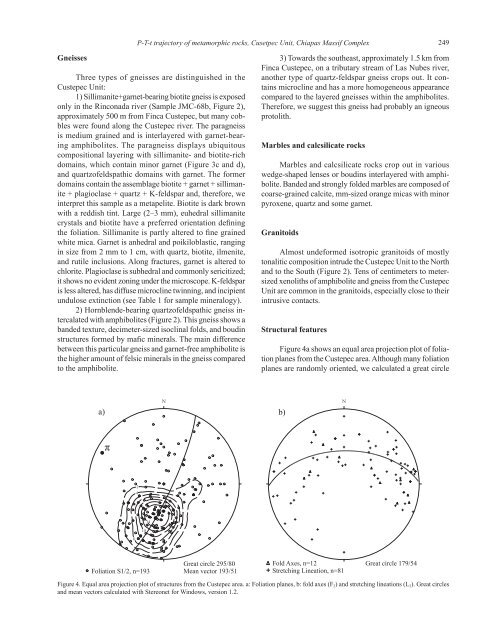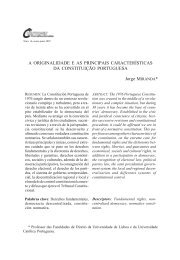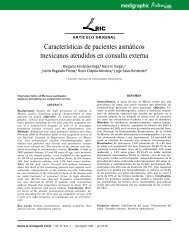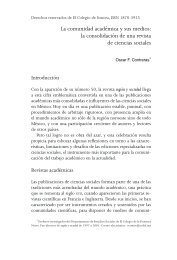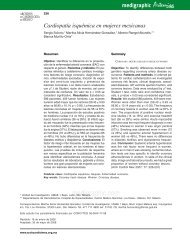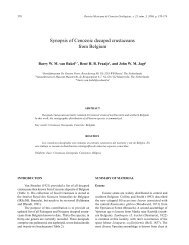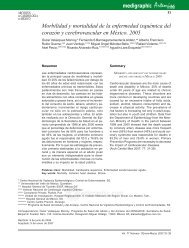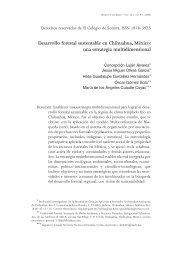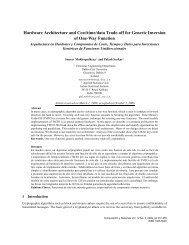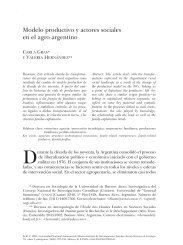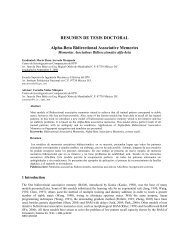P-T-t trajectory of metamorphic rocks from the central ... - SciELO
P-T-t trajectory of metamorphic rocks from the central ... - SciELO
P-T-t trajectory of metamorphic rocks from the central ... - SciELO
You also want an ePaper? Increase the reach of your titles
YUMPU automatically turns print PDFs into web optimized ePapers that Google loves.
P-T-t <strong>trajectory</strong> <strong>of</strong> <strong>metamorphic</strong> <strong>rocks</strong>, Cusetpec Unit, Chiapas Massif Complex 249<br />
Gneisses<br />
Three types <strong>of</strong> gneisses are distinguished in <strong>the</strong><br />
Custepec Unit:<br />
1) Sillimanite+garnet-bearing biotite gneiss is exposed<br />
only in <strong>the</strong> Rinconada river (Sample JMC-68b, Figure 2),<br />
approximately 500 m <strong>from</strong> Finca Custepec, but many cobbles<br />
were found along <strong>the</strong> Custepec river. The paragneiss<br />
is medium grained and is interlayered with garnet-bearing<br />
amphibolites. The paragneiss displays ubiquitous<br />
compositional layering with sillimanite- and biotite-rich<br />
domains, which contain minor garnet (Figure 3c and d),<br />
and quartz<strong>of</strong>eldspathic domains with garnet. The former<br />
domains contain <strong>the</strong> assemblage biotite + garnet + sillimanite<br />
+ plagioclase + quartz + K-feldspar and, <strong>the</strong>refore, we<br />
interpret this sample as a metapelite. Biotite is dark brown<br />
with a reddish tint. Large (2–3 mm), euhedral sillimanite<br />
crystals and biotite have a preferred orientation defining<br />
<strong>the</strong> foliation. Sillimanite is partly altered to fine grained<br />
white mica. Garnet is anhedral and poikiloblastic, ranging<br />
in size <strong>from</strong> 2 mm to 1 cm, with quartz, biotite, ilmenite,<br />
and rutile inclusions. Along fractures, garnet is altered to<br />
chlorite. Plagioclase is subhedral and commonly sericitized;<br />
it shows no evident zoning under <strong>the</strong> microscope. K-feldspar<br />
is less altered, has diffuse microcline twinning, and incipient<br />
undulose extinction (see Table 1 for sample mineralogy).<br />
2) Hornblende-bearing quartz<strong>of</strong>eldspathic gneiss intercalated<br />
with amphibolites (Figure 2). This gneiss shows a<br />
banded texture, decimeter-sized isoclinal folds, and boudin<br />
structures formed by mafic minerals. The main difference<br />
between this particular gneiss and garnet-free amphibolite is<br />
<strong>the</strong> higher amount <strong>of</strong> felsic minerals in <strong>the</strong> gneiss compared<br />
to <strong>the</strong> amphibolite.<br />
3) Towards <strong>the</strong> sou<strong>the</strong>ast, approximately 1.5 km <strong>from</strong><br />
Finca Custepec, on a tributary stream <strong>of</strong> Las Nubes river,<br />
ano<strong>the</strong>r type <strong>of</strong> quartz-feldspar gneiss crops out. It contains<br />
microcline and has a more homogeneous appearance<br />
compared to <strong>the</strong> layered gneisses within <strong>the</strong> amphibolites.<br />
Therefore, we suggest this gneiss had probably an igneous<br />
protolith.<br />
Marbles and calcsilicate <strong>rocks</strong><br />
Marbles and calcsilicate <strong>rocks</strong> crop out in various<br />
wedge-shaped lenses or boudins interlayered with amphibolite.<br />
Banded and strongly folded marbles are composed <strong>of</strong><br />
coarse-grained calcite, mm-sized orange micas with minor<br />
pyroxene, quartz and some garnet.<br />
Granitoids<br />
Almost undeformed isotropic granitoids <strong>of</strong> mostly<br />
tonalitic composition intrude <strong>the</strong> Custepec Unit to <strong>the</strong> North<br />
and to <strong>the</strong> South (Figure 2). Tens <strong>of</strong> centimeters to metersized<br />
xenoliths <strong>of</strong> amphibolite and gneiss <strong>from</strong> <strong>the</strong> Custepec<br />
Unit are common in <strong>the</strong> granitoids, especially close to <strong>the</strong>ir<br />
intrusive contacts.<br />
Structural features<br />
Figure 4a shows an equal area projection plot <strong>of</strong> foliation<br />
planes <strong>from</strong> <strong>the</strong> Custepec area. Although many foliation<br />
planes are randomly oriented, we calculated a great circle<br />
N<br />
a) b)<br />
N<br />
π<br />
2<br />
4<br />
14<br />
10<br />
6.<br />
Foliation S1/2, n=193<br />
Great circle 295/80<br />
Mean vector 193/51<br />
Fold Axes, n=12<br />
Stretching Lineation, n=81<br />
Great circle 179/54<br />
Figure 4. Equal area projection plot <strong>of</strong> structures <strong>from</strong> <strong>the</strong> Custepec area. a: Foliation planes, b: fold axes (F 2 ) and stretching lineations (L 2 ). Great circles<br />
and mean vectors calculated with Stereonet for Windows, version 1.2.


